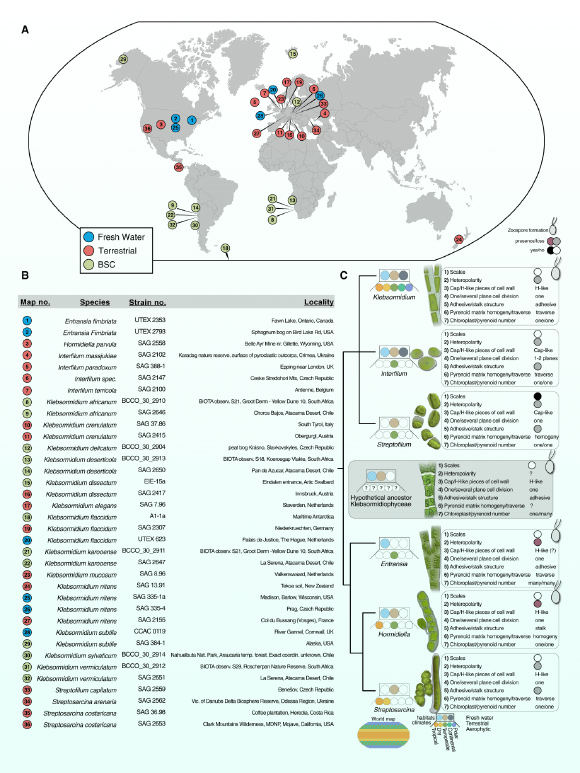New research led by University of Goettingen scientists provides evidence that the first multicellular streptophytes likely lived about a billion years ago.
Bierenbroodspot et al. sequenced 24 new transcriptomes of Klebsormidiophyceae and combined them with 14 previously published genomic and transcriptomic datasets. Image credit: Bierenbroodspot et al., doi: 10.1016/j.cub.2023.12.070.
Streptophytes are best known as the clade of plants containing the teeming diversity of embryophytes (land plants).
Next to embryophytes are, however, a range of freshwater and terrestrial algae that bear important information on the emergence of key traits of land plants.
Among these, the Klebsormidiophyceae stand out. Thriving in diverse environments — from mundane (ubiquitous occurrence on tree barks and rocks) to extreme (from the Atacama Desert to the Antarctic) — Klebsormidiophyceae can exhibit filamentous body plans and display remarkable resilience as colonizers of terrestrial habitats.
Currently, the lack of a robust phylogenetic framework for the Klebsormidiophyceae hampers our understanding of the evolutionary history of these key traits.
“It’s really fascinating that these tiny robust little organisms have such a high diversity in their morphology and also are extremely well adapted to live in sometimes very harsh environments,” said Dr. Tatyana Darienko, co-first author of the study.
“Our comprehensive sampling aimed to create a global distribution map for Klebsormidiophyceae, emphasizing their adaptability, ecological significance, and hidden diversity.”
“Based on genetic data calibrated by fossils, we performed molecular clock analyses.”
While delving into the complex evolutionary history of Klebsormidiophyceae, Dr. Darienko and her colleagues faced challenges in resolving phylogenetic relationships using traditional markers.
To overcome this, they employed hundreds of genes obtained from the transcriptomes of 24 isolates from different continents and habitats.
“Our approach, known as phylogenomics, was to reconstruct the evolutionary history taking into account whole genomes or large fractions of genomes,” said Dr. Iker Irisarri, co-senior author of the study.
“This extremely powerful method can reconstruct evolutionary relationships with very high precision.”
The researchers revealed a new phylogenomic tree of life for Klebsormidiophyceae, which is divided into three orders.
“This deep dive into the phylogenomic framework and our molecular clock unveiled Klebsormidiophyceae’s ancient ancestor — a multicellular entity thriving millions of years ago whose descendants began to split into three distinct branches over 800 million years ago,” said co-first author Maaike Bierenbroodspot.
The scientists explore the evolutionary history of multicellularity within streptophytes.
They found that an ancient common ancestor of land plants, other streptophyte algae, and Klebsormidiophyceae was already multicellular.
“This finding sheds light on the genetic potential for multicellularity among streptophytes, indicating an ancient origin for this crucial trait almost a billion years ago,” said co-author Professor Jan de Vries.
The study was published in the journal Current Biology.
_____
Maaike J. Bierenbroodspot et al. Phylogenomic insights into the first multicellular streptophyte. Current Biology, published online January 19, 2024; doi: 10.1016/j.cub.2023.12.070


